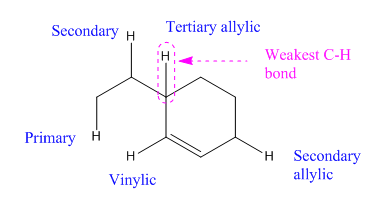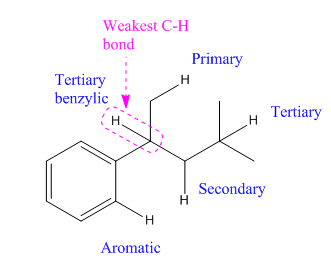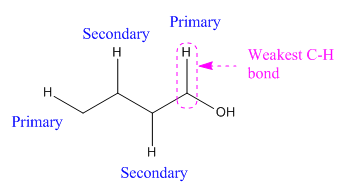
(a)
Interpretation:
The weakest
Concept introduction:
The carbon atom attached to more number of alkyl group form weaker bond
The weakest bond has the smallest
Answer to Problem 25.32P
The weakest

Explanation of Solution
The given compound with types of

Here different types of
The weakest bond in the given compound is marked in the square:

The weakest
(b)
Interpretation:
The weakest
Concept introduction:
The carbon atom attached to more number of alkyl group form weaker bond
The weakest bond has the smallest bond dissociation energy value.
Answer to Problem 25.32P
The weakest

Explanation of Solution
The given compound with types of

Here different types of
The weakest bond in the given compound is marked in the square:

The weakest
(c)
Interpretation:
The weakest
Concept introduction:
The carbon atom attached to more number of alkyl group form weaker bond
The weakest bond has the smallest bond dissociation energy value.
Answer to Problem 25.32P
The weakest

Explanation of Solution
The given compound with types of

Here different types of

The weakest bond in the given compound is marked in the square:

The weakest
Want to see more full solutions like this?
Chapter 25 Solutions
ORG.CHEM W/TEXT+SOLU.MANUAL
 ChemistryChemistryISBN:9781305957404Author:Steven S. Zumdahl, Susan A. Zumdahl, Donald J. DeCostePublisher:Cengage Learning
ChemistryChemistryISBN:9781305957404Author:Steven S. Zumdahl, Susan A. Zumdahl, Donald J. DeCostePublisher:Cengage Learning ChemistryChemistryISBN:9781259911156Author:Raymond Chang Dr., Jason Overby ProfessorPublisher:McGraw-Hill Education
ChemistryChemistryISBN:9781259911156Author:Raymond Chang Dr., Jason Overby ProfessorPublisher:McGraw-Hill Education Principles of Instrumental AnalysisChemistryISBN:9781305577213Author:Douglas A. Skoog, F. James Holler, Stanley R. CrouchPublisher:Cengage Learning
Principles of Instrumental AnalysisChemistryISBN:9781305577213Author:Douglas A. Skoog, F. James Holler, Stanley R. CrouchPublisher:Cengage Learning Organic ChemistryChemistryISBN:9780078021558Author:Janice Gorzynski Smith Dr.Publisher:McGraw-Hill Education
Organic ChemistryChemistryISBN:9780078021558Author:Janice Gorzynski Smith Dr.Publisher:McGraw-Hill Education Chemistry: Principles and ReactionsChemistryISBN:9781305079373Author:William L. Masterton, Cecile N. HurleyPublisher:Cengage Learning
Chemistry: Principles and ReactionsChemistryISBN:9781305079373Author:William L. Masterton, Cecile N. HurleyPublisher:Cengage Learning Elementary Principles of Chemical Processes, Bind...ChemistryISBN:9781118431221Author:Richard M. Felder, Ronald W. Rousseau, Lisa G. BullardPublisher:WILEY
Elementary Principles of Chemical Processes, Bind...ChemistryISBN:9781118431221Author:Richard M. Felder, Ronald W. Rousseau, Lisa G. BullardPublisher:WILEY





